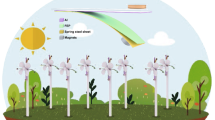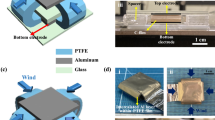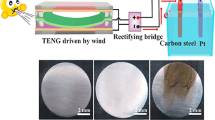Abstract
Energy is the most dependable need of the current era. With the tendency in portable electronics and self-powered systems, researchers have been developing nanogenerators and utilizing them as self-powered energy source. High output and optimum efficiency are always a key concern. Hence, in this research work, a hybrid NG based on both piezoelectric and triboelectric phenomena is proposed and utilized for harvesting wind energy. The UV curable polyurethane (PU) and a composite of zinc oxide (ZnO) in powder form with UV curable PU (ZnO + PU) are utilized for fabricating the triboelectric NG (TENG) and Piezoelectric NG (PNG), respectively. To combine the effect of both PNG and TENG, these two nanogenerators are stacked using a sponge as a spacer by providing a uniform air gap for triboelectrification. The hybrid nanogenerator module was connected in parallel to collect the electrical energy harvested. The fabricated hybrid nanogenerators effectively produced an open-circuit voltage of ~ 120 V and current density of ~ 140 µA cm−2 across 50 Ω resistor during fast speed wind from a stand fan. Apart from that, the developed hybrid NG can light up to 50 commercial LEDs, implying that the proposed hybrid NG can be used as a self-powered energy source in portable electronics, wireless and monitoring systems.








Similar content being viewed by others
References
X. Pu, L. Li, H. Song, C. Du, Z. Zhao, C. Jiang, G. Cao, W. Hu, Z.L. Wang, A Self-charging power unit by integration of a textile triboelectric nanogenerator and a flexible lithium-ion battery for wearable electronics. Adv. Mater. 27(15), 2472–2478 (2015). https://doi.org/10.1002/adma.201500311
X. Wang, J. Song, J. Liu, Z.L. Wang, Direct-Current Nanogenerator Driven by Ultrasonic Waves. Science (80-) 316(5821), 102–105 (2007).
B. Kang, G. Ceder, Battery materials for ultrafast charging and discharging. Nature 458(7235), 190–193 (2009). https://doi.org/10.1038/nature07853
C.K. Chan, H. Peng, G. Liu, K. McIlwrath, X.F. Zhang, R.A. Huggins, Y. Cui, High-performance lithium battery anodes using silicon nanowires. Nat. Nanotechnol. 3(1), 31–35 (2008). https://doi.org/10.1038/nnano.2007.411
F.R. Fan, Z.Q. Tian, Z.L. Wang, Flexible triboelectric generator. Nano Energy 1(2), 328–334 (2012). https://doi.org/10.1016/j.nanoen.2012.01.004
B. Yang, C. Lee, R.K. Kotlanka, J. Xie, S.P. Lim, A MEMS rotary comb mechanism for harvesting the kinetic energy of planar vibrations. J. Micromech. Microeng. 20(6), 65017 (2010). https://doi.org/10.1088/0960-1317/20/6/065017
H. Liu, C.J. Tay, C. Quan, T. Kobayashi, C. Lee, Piezoelectric MEMS energy harvester for low-frequency vibrations with wideband operation range and steadily increased output power. J. Microelectromech. Syst. 20(5), 1131–1142 (2011). https://doi.org/10.1109/JMEMS.2011.2162488
C. Chang, V.H. Tran, J. Wang, Y.K. Fuh, L. Lin, Direct-write piezoelectric polymeric nanogenerator with high energy conversion efficiency. Nano Lett. 10(2), 726–731 (2010). https://doi.org/10.1021/nl9040719
A. Tamang, S.K. Ghosh, S. Garain, M.M. Alam, J. Haeberle, K. Henkel, D. Schmeisser, D. Mandal, DNA-assisted β-phase nucleation and alignment of molecular dipoles in PVDF film: a realization of self-poled bioinspired flexible polymer nanogenerator for portable electronic devices. ACS Appl. Mater. Interfaces 7(30), 16143–16147 (2015). https://doi.org/10.1021/acsami.5b04161
S. Chandrasekaran, C. Bowen, J. Roscow, Y. Zhang, D.K. Dang, E.J. Kim, R.D.K. Misra, L. Deng, J.S. Chung, S.H. Hur, Micro-scale to nano-scale generators for energy harvesting: self powered piezoelectric, triboelectric and hybrid devices. Phys. Rep. 792, 1–33 (2019). https://doi.org/10.1016/j.physrep.2018.11.001
A. Nechibvute, A. Chawanda, P. Luhanga, Piezoelectric energy harvesting devices: an alternative energy source for wireless sensors. Smart Mater. Res. 2012, 853481 (2012). https://doi.org/10.1155/2012/853481
C. Wu, A.C. Wang, W. Ding, H. Guo, Z.L. Wang, Triboelectric nanogenerator: a foundation of the energy for the new era. Adv. Energy Mater. 9(1), 1–25 (2019). https://doi.org/10.1002/aenm.201802906
W. Yang, J. Chen, Q. Jing, J. Yang, X. Wen, Y. Su, G. Zhu, P. Bai, Z.L. Wang, 3D stack integrated triboelectric nanogenerator for harvesting vibration energy. Adv. Funct. Mater. 24(26), 4090–4096 (2014). https://doi.org/10.1002/adfm.201304211
B. Zhang, J. Chen, L. Jin, W. Deng, L. Zhang, H. Zhang, M. Zhu, W. Yang, Z.L. Wang, Rotating-disk-based hybridized electromagnetic-triboelectric nanogenerator for sustainably powering wireless traffic volume sensors. ACS Nano 10(6), 6241–6247 (2016). https://doi.org/10.1021/acsnano.6b02384
M. Han, X.S. Zhang, B. Meng, W. Liu, W. Tang, X. Sun, W. Wang, H. Zhang, r-shaped hybrid nanogenerator with enhanced piezoelectricity. ACS Nano 7(10), 8554–8560 (2013). https://doi.org/10.1021/nn404023v
W.S. Jung, M.G. Kang, H.G. Moon, S.H. Baek, S.J. Yoon, Z.L. Wang, S.W. Kim, C.Y. Kang, High output piezo/triboelectric hybrid generator. Sci. Rep. 5(1), 9309 (2015). https://doi.org/10.1038/srep09309
Y. Qin, X. Wang, Z.L. Wang, Microfibre–nanowire hybrid structure for energy scavenging. Nature 451(7180), 809–813 (2008). https://doi.org/10.1038/nature06601
X. Wang, B. Yang, J. Liu, Y. Zhu, C. Yang, Q. He, A flexible triboelectric-piezoelectric hybrid nanogenerator based on P(VDF-TrFE) nanofibers and PDMS/MWCNT for wearable devices. Sci. Rep. 6(1), 36409 (2016). https://doi.org/10.1038/srep36409
D. Mao, B.E. Gnade, M.A. Quevedo-Lopez, Ferroelectric Properties and Polarization Switching Kinetic of Poly (Vinylidene Fluoride-Trifluoroethylene) Copolymer, Ch. 4. IntechOpen (2011).
M. Li, Y. Jie, L.H. Shao, Y. Guo, X. Cao, N. Wang, Z.L. Wang, All-in-one cellulose based hybrid tribo/piezoelectric nanogenerator. Nano Res. 12(8), 1831–1835 (2019). https://doi.org/10.1007/s12274-019-2443-3
G. Hassan, F. Khan, A. Hassan, S. Ali, J. Bae, C.H. Lee, A flat-panel-shaped hybrid piezo/triboelectric nanogenerator for ambient energy harvesting. Nanotechnology 28(17), 175402 (2017). https://doi.org/10.1088/1361-6528/aa65c3
L. Han, X. Lu, M. Wang, D. Gan, W. Deng, K. Wang, L. Fang, K. Liu, C.W. Chan, Y. Tang, L.T. Weng, A mussel-inspired conductive, self-adhesive, and self-healable tough hydrogel as cell stimulators and implantable bioelectronics. Small 13(2), 1601916 (2017). https://doi.org/10.1002/smll.201601916
G. Cai, J. Wang, K. Qian, J. Chen, S. Li, P.S. Lee, Extremely stretchable strain sensors based on conductive self-healing dynamic cross-links hydrogels for human-motion detection. Adv. Sci. 4(2), 1600190 (2017). https://doi.org/10.1002/advs.201600190
Y. Zhang T. Nayak, H. Hong, W. Cai, Biomedical applications of zinc oxide nanomaterials. Curr. Mol. Med. 13(10), 1633–1645 (2013). https://doi.org/10.2174/1566524013666131111130058.
M. Willander, O. Nur, Q.X. Zhao, L.L. Yang, M. Lorenz, B.Q. Cao, J.Z. Pérez, C. Czekalla, G. Zimmermann, M. Grundmann, A. Bakin, Zinc oxide nanorod based photonic devices: Recent progress in growth, lightemitting diodes and lasers. Nanotechnology 20(33) (2009). https://doi.org/10.1088/0957-4484/20/33/332001.
T. Kamilya, P.K. Sarkar, S. Acharya, Unveiling peritoneum membrane for a robust triboelectric nanogenerator. ACS Omega 4(18), 17684–17690 (2019). https://doi.org/10.1021/acsomega.9b01963
S. Niu, S. Wang, L. Lin, Y. Liu, Y.S. Zhou, Y. Hu, Z.L. Wang, Theoretical study of contact-mode triboelectric nanogenerators as an effective power source. Energy Environ. Sci. 6(12), 3576–3583 (2013). https://doi.org/10.1039/c3ee42571a
S. Niu, Y. Liu, S. Wang, L. Lin, Y.S. Zhou, Y. Hu, Z.L. Wang, Theoretical investigation and structural optimization of single-electrode triboelectric nanogenerators. Adv. Funct. Mater. 24(22), 3332–3340 (2014). https://doi.org/10.1002/adfm.201303799
Z.L. Wang, J. Chen, L. Lin, Progress in triboelectric nanogenerators as a new energy technology and self-powered sensors. Energy Environ. Sci. 8(8), 2250–2282 (2015). https://doi.org/10.1039/c5ee01532d
L.D. Agnol, F.T.G. Dias, H.L. Ornaghi Jr., M. Sangermano, O. Bianchi, UV-curable waterborne polyurethane coatings: a state-of-the-art and recent advances review. Prog. Org. Coat. 154, 106156 (2021). https://doi.org/10.1016/j.porgcoat.2021.106156
J. Fu, L. Wang, H. Yu, M. Haroon, F. Haq, W. Shi, B. Wu, L. Wang, Research progress of UV-curable polyurethane acrylate-based hardening coatings. Prog. Org. Coat. 131, 82–99 (2019). https://doi.org/10.1016/j.porgcoat.2019.01.061
S.A. Guelcher, Biodegradable polyurethanes: synthesis and applications in regenerative medicine. Tissue Eng. B Rev. 14(1), 3–17 (2008). https://doi.org/10.1089/teb.2007.0133
X. Zhang, K.G. Battiston, J.E. McBane, L.A. Matheson, R.S. Labow, J.P. Santerre, Design of biodegradable polyurethanes and the interactions of the polymers and their degradation by-products within in vitro and in vivo environments. Adv. Polyurethane Biomater. 75–114 (2016).
Z.L. Wang, ZnO nanowire and nanobelt platform for nanotechnology. Mater. Sci. Eng. R 64(3–4), 33–71 (2009). https://doi.org/10.1016/j.mser.2009.02.001
C.L. Hsu, K.C. Chen, Improving piezoelectric nanogenerator comprises ZnO nanowires by bending the flexible PET substrate at low vibration frequency. J. Phys. Chem. C 116(16), 9351–9355 (2012). https://doi.org/10.1021/jp301527y
A. Khan, M. Hussain, M.A. Abbasi, Z.H. Ibupoto, O. Nur, M. Willander, Analysis of junction properties of gold-zinc oxide nanorods-based Schottky diode by means of frequency dependent electrical characterization on textile. J. Mater. Sci. 49(9), 3434–3441 (2014). https://doi.org/10.1007/s10853-014-8053-2
S. Niu, Y.S. Zhou, S. Wang, Y. Liu, L. Lin, Y. Bando, Z.L. Wang, Simulation method for optimizing the performance of an integrated triboelectric nanogenerator energy harvesting system. Nano Energy 8, 150–156 (2014). https://doi.org/10.1016/j.nanoen.2014.05.018
Funding
This research did not receive any specific grant from funding agencies in the public, commercial, or not-for-profit sectors.
Author information
Authors and Affiliations
Corresponding authors
Ethics declarations
Conflict of interest
All the authors contributed to this research work have no conflict of interest.
Additional information
Publisher's Note
Springer Nature remains neutral with regard to jurisdictional claims in published maps and institutional affiliations.
Rights and permissions
About this article
Cite this article
Ali, I., Hassan, G. & Shuja, A. Fabrication of self-healing hybrid nanogenerators based on polyurethane and ZnO for harvesting wind energy. J Mater Sci: Mater Electron 33, 3982–3993 (2022). https://doi.org/10.1007/s10854-021-07591-x
Received:
Accepted:
Published:
Issue Date:
DOI: https://doi.org/10.1007/s10854-021-07591-x




